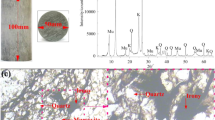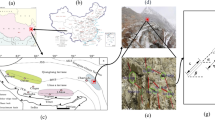Abstract
Load-carrying cruciform fillet welded joint is commonly encountered in on-shore and offshore structures. In this study, the stress intensity magnification factors (Mkm) of such configuration containing a 3-D semi-elliptical surface crack at the weld toe are analysed using 3-D finite element analyses. Due to the non-penetrating fillet welds at the intersection of the main plate and transverse stiffener, the Mkm values are found to be much larger than the corresponding results of non-load-carrying cruciform welded joints. Therefore, a new set Mkm equations for load-carrying joints are built up using multiple regression analyses, and statistical analyses are carried out to validate the goodness of fit of these equations. It is noted that the existing British Standard 7910 (BS 7910) assessment equation produces an over-conservative prediction on Mkm values as compared with the newly proposed Mkm equations, and the largest over-estimation percentage difference is as high as 257.8%.













Similar content being viewed by others
References
ABAQUS. (2011). Standard user’s manual. Version 6.11, Hibbett, Karlsson & Sorensen Inc, USA.
Andrews, R. M. (1996). The effect of misalignment on the fatigue strength of welded cruciform joints. Fatigue and Fracture of Engineering Materials and Structures, 19(6), 755–768.
Bowness, D., & Lee, M. M. K. (1996). Stress intensity factor solutions for semi-elliptical weld-toe cracks in T-butt geometries. Fatigue and Fracture of Engineering Materials and Structures, 19(6), 787–797.
Bowness, D., & Lee, M. M. K. (2000). Fracture mechanics assessment of fatigue cracks in offshore tubular structures. Offshore Technology Report 077, Health and Safety Executive, UK.
Bowness, D., & Lee, M. M. K. (2000b). Prediction of weld toe magnification factors for semi-elliptical cracks in T-butt joints. International Journal of Fatigue, 22(5), 369–387.
BS7910-Amendment 1. (2013). Guide to methods for assessing the acceptability of flaws in metallic structures. British Standards Institution, UK.
FEACrack™. (2010). User’s manual. Version 3.2, Quest Integirty Group LLC, USA.
Ferreira, J. M., & Branco, C. M. (1991). Influence of fillet weld joint geometry on fatigue crack growth. Theoretical and Applied Fracture Mechanics, 15(2), 131–142.
Fisher, J. W., & Frank, K. H. (1979). Fatigue strength of fillet welded cruciform joints. Journal of the Structural Division, 105(9), 1727–1740.
Guha, B. (1995). A new fracture mechanics method to predict the fatigue life of welded cruciform joints. Engineering Fracture Mechanics, 52(2), 215–229.
Han, J. W., Han, D. K., & Han, S. H. (2014). Stress intensity factors for three-dimensional weld toe cracks using weld toe magnification factors. Fatigue and Fracture of Engineering Materials and Structures, 37(2), 146–156.
Japanese Society of Steel Construction. (1995). Fatigue design recommendations for steel structures. JSSC Technical Report, No. 32.
Kainuma, S., & Mori, T. (2006). A fatigue strength evaluation method for load-carrying fillet welded cruciform joints. International Journal of Fatigue, 28(8), 864–872.
Kainuma, S., & Mori, T. (2008). A study on fatigue crack initiation point of load-carrying fillet welded cruciform joints. International Journal of Fatigue, 30(9), 1669–1677.
Kim, I. T., & Kainuma, S. (2005). Fatigue life assessment of load-carrying fillet-welded cruciform joints inclined to uniaxial cyclic loading. International Journal of Pressure Vessels and Piping, 82(11), 807–813.
Lie, S. T., Vipin, S. P., & Li, T. (2015). New weld toe magnification factors for semi-elliptical cracks in double-sided T-butt joints and cruciform X-joints. International Journal of Fatigue, 80, 178–191.
Lie, S. T., Zhao, H. S., & Vipin, S. P. (2017). New weld toe magnification factors for semi-elliptical cracks in plate-to-plate butt-welded joints. Fatigue and Fracture of Engineering Materials and Structures, 40(2), 207–220.
Miki, C., Tateishi, K., Fan, H. D., & Tanaka, M. (1993). Fatigue strengths of fillet-welded joints containing root discontinuities. International Journal of Fatigue, 15(2), 133–140.
Motarjemi, A. K., Kokabi, A. H., Ziaie, A. A., Manteghi, S., & Burdekin, F. M. (2000). Comparison of the stress intensity factor of T and cruciform welded joints with different main and attachment plate thickness. Engineering Fracture Mechanics, 65(1), 55–66.
Newman, J. C., & Raju, I. S. (1981). An empirical stress-intensity factor equation for the surface crack. Engineering Fracture Mechanics, 15(1–2), 185–192.
Nykänen, T., Li, X., Björk, T., & Marquis, G. (2005). A parametric fracture mechanics study of welded joints with toe cracks and lack of penetration. Engineering Fracture Mechanics, 72(10), 1580–1609.
Pang, J. H. L., Tsang, K. S., & Hoh, H. J. (2016). 3D stress intensity factors for weld toe semi-elliptical surface cracks using XFEM. Marine Structures, 48, 1–14.
Saiprasertkit, K., Hanji, T., & Miki, C. (2012). Fatigue strength assessment of load-carrying cruciform joints with material mismatching in low- and high-cycle fatigue regions based on the effective notch concept. International Journal of Fatigue, 40, 120–128.
Saiprasertkit, K., Sasaki, E., & Miki, C. (2014). Fatigue crack initiation point of load carrying cruciform joints in low and high cycle fatigue regions. International Journal of Fatigue, 59, 153–158.
Smith, I. F. C., & Smith, R. A. (1983). Fatigue crack growth in a fillet welded joint. Engineering Fracture Mechanics, 18(4), 861–869.
Xu, K., Lu, Y., & Lie, S. T. (2005). Loading-carrying welds joints analysis using boundary element method. International Journal of Solids and Structures, 42, 2965–2975.
Zhao, H. S., & Lie, S. T. (2017). Determination of dimensionless stress intensity factor of plate-to-plate butt welds between axially aligned members of different thickness. Engineering Fracture Mechanics, 172, 90–105.
Zhao, H. S., Lie, S. T., & Zhang, Y. (2017). Stress intensity factors for semi-elliptical surface cracks in plate-to-plate butt welds with parallel misalignment of same thickness. Marine Structures, 53, 148–163.
Author information
Authors and Affiliations
Corresponding author
Rights and permissions
About this article
Cite this article
Zhao, H., Lie, S.T. & Zhang, Y. Prediction of Stress Intensity Magnification Factors of a Weld Toe Crack in Load-Carrying Cruciform Fillet Welded Joints Under Axial Loading. Int J Steel Struct 19, 978–990 (2019). https://doi.org/10.1007/s13296-018-0178-8
Received:
Accepted:
Published:
Issue Date:
DOI: https://doi.org/10.1007/s13296-018-0178-8




